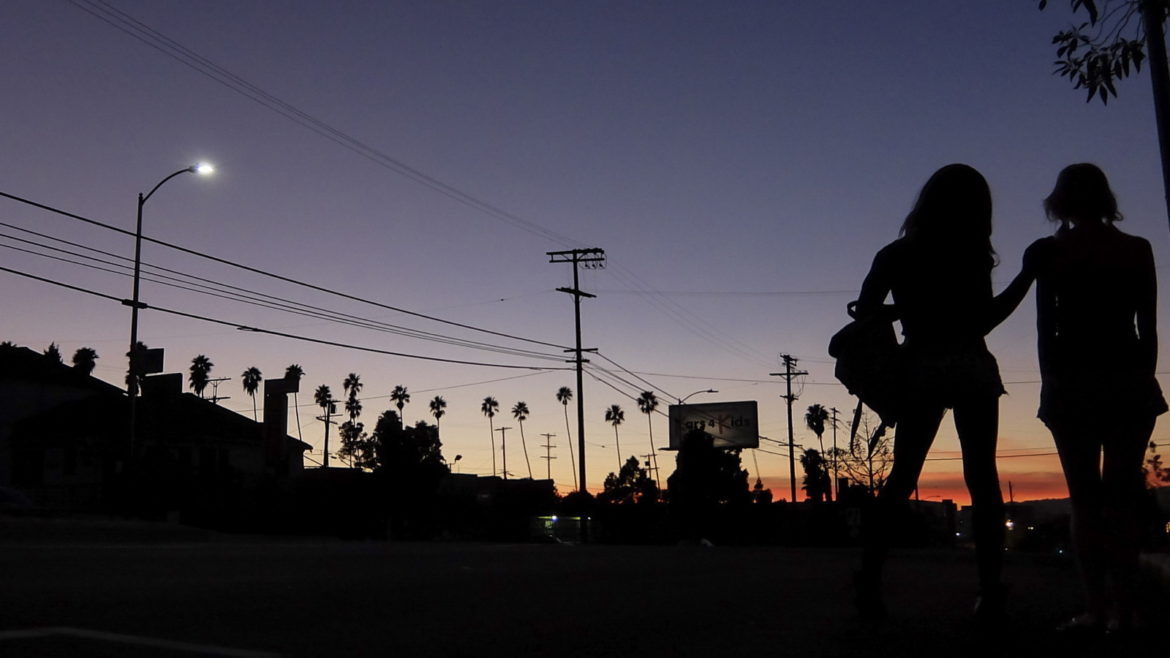Describing Sean Baker’s Tangerine is essentially making a list of dodgy propositions. It was shot entirely on iPhone 5s. It features two non-actors in the leads (though surrounds them with more established people like James Ransone, who played Ziggy on The Wire and will appear in the upcoming Sinister 2, and a whole cast of Armenian performers who are well-known abroad). Its narrative follows a day in the life of two trans sex workers in L.A. – and that day happens to be Christmas Eve.
It’s not hard to imagine this going poorly, or diving deep into maudlin melodrama or even exploitation. There’s a relief when it doesn’t. Tangerine is ultimately ingratiating and compassionate – it’s screamingly loud at the beginning (and elsewhere) but nearly silent at the end. It has a tenderness that sneaks up on you.
Sin-Dee (Kitana Kiki Rodriguez) is fresh out of jail. She meets up with her best friend Alexandra (Mya Taylor) and they make their way across town. Alexandra has some sort of show later on in the evening, and passes out flyers everywhere she goes (hilariously, including at the end of otherwise antagonistic encounters), but all consideration of this is dwarfed by Sin-Dee’s discovery that her boyfriend/pimp has been cheating on her while she was locked up. The two traverse the city, trying to find this lover, who they only know has a name that starts with a D, for the express purpose of fucking her up. That’s Sin-Dee’s plan, anyway; Alexandra’s exasperation with her friend shows from the start.
Their frantic journey of jealous comeuppance is juxtaposed with Razmik (Karren Karugulian), a married Armenian cab driver with a kid, and who, as it turns out, knows the trans sex worker community pretty damn well. Baker and fellow screenwriter Chris Bergoch fill the back of Razmik’s cab with a cross-section of an “underworld” community that doesn’t seem very hidden in this vision of L.A. – drunks, junkies, pimps, and prostitutes make up most of the world we meet.
All the while, Sin-Dee and Alexandra scour the land, searching. The camera – sometimes jerky and nervous, often edited to match the dub-step and hip-hop rhythms of the film’s Soundcloud-curated score – drags us along. The two eventually find their prey, and a harrowing several minutes transpires before a tonal shift takes the anxiety down a notch, and the film settles into a more contemplative mood.
That is, until all the characters’ paths cross simultaneously – not just our two protagonists and the woman they basically kidnapped, but also Ransone’s Chester, Razmik, his mother-in-law, his wife, and child – in a late-night donut shop. Things get dialed back up pretty fast and pretty loud.
It’s best not to talk about the closing frames, but they’re wonderful – after all the drama, we land on a moment of deep vulnerability and companionship that’s all the more striking for its relative silence.
At the beginning of the film, there’s a real sense that the characterizations of Sin-Dee and Alexandra might go too broad – everything is Bitch this and Bitch that – but as the film progresses, it finds a lot more depth than its opening moments suggest. These are characters we rarely see, and that alone is valuable (though the recent Sworn Virgin, also screened at SF International Film Fest, addressed trans issues too, from a very different angle).
Ransone is, unsurprisingly, a standout, and Karugulian conveys his cab-driver’s familial dissatisfaction and sexual repression well. (The connection between the relative sexual freedom he discovers in his cab and the oppressive aspects of his immigrant home life could’ve gotten more attention, though.) The two leads may just be playing versions of themselves, but they do that engagingly; Taylor, especially, inhabits her character, the quieter and more self-aware of the two. I hope she gets more work on screen.
The tiny, digital elephants in the room, of course, are the iPhones. How does it work in the end? I think it works very well, overall. There’s a kinetic momentum behind the film that compliments the handheld shots and the pulsing, frantic soundtrack. During some tracking shots, the jitteriness is distracting, but not in the standard way – rather than the dizzy-making vibe that often accompanies such experiments, it’s more as though everything were a few frames per second too many (though Baker and Bergoch, in the Q&A at SFIFF, said this was not technically the case). It did not come off gimmicky, though I’d be surprised if any viewer wasn’t able to notice that something was different about the image. More often than not, though, it’s effective. There’s a visceral sense of the L.A. streets and the characters who inhabit them, and the medium aligns with the message.
The possibility that – with a couple of phones, some stabilizing equipment, editing software, and the vast amount of independently created music available online from young artists – you can just go out and make a movie is undeniably exciting. It holds the promise of lowering the barrier of entry to visual storytelling, which has always been the dream of independent film. There are some kinks to be worked out, and technical issues to be determined, but in the end, it means that more stories might be told, which we’d never otherwise discover. Will some of them be terrible? Probably. But Tangerine isn’t.
Debates about the decline of celluloid and “true film” forget this too often. Personally, I want both masterful visions on film and upstart provocations from those working on the margins with new technology. Tangerine wasn’t my favorite film of the year so far, but it’s 2015’s most audacious challenge to filmmakers and viewers. If you have a good story, and some performers, and some time, and a phone or two, why not make a movie? And if you’re not going to make your movie, who will?

